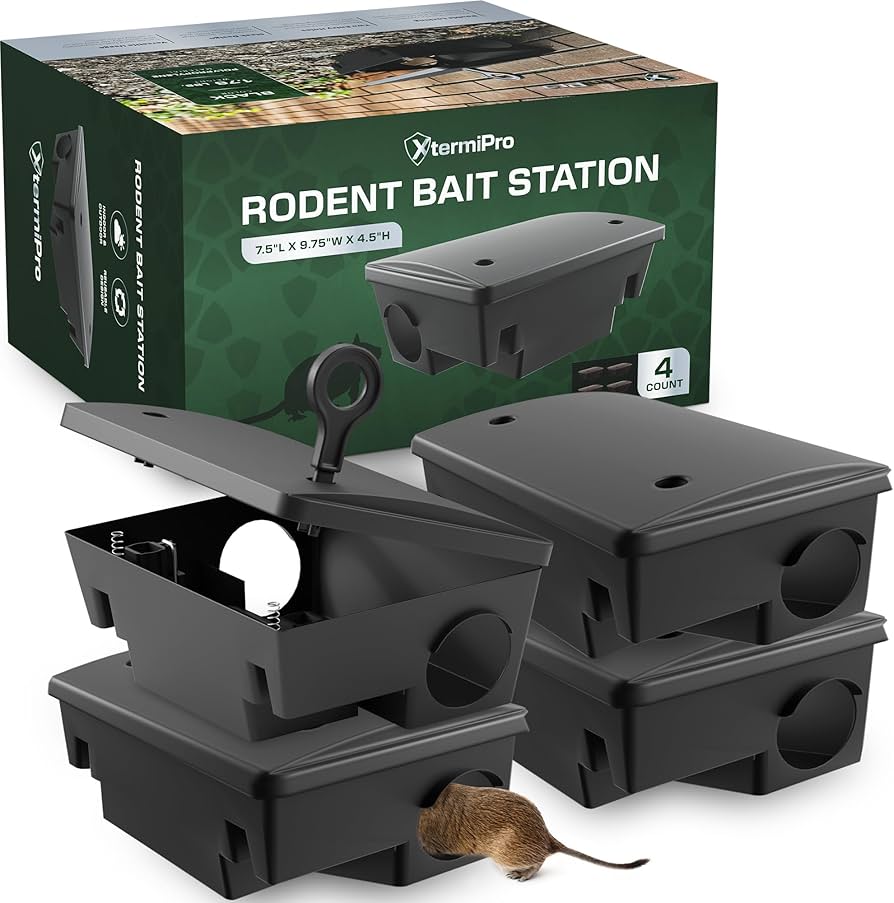Cost To Rodent Proof A House: Ultimate Guide to Save Money
Are you worried about rodents sneaking into your home? You’re not alone.
Rodents can cause serious damage and health risks if left unchecked. But how much does it really cost to rodent proof a house? Knowing the answer can help you protect your home without breaking the bank. You’ll discover clear, straightforward information about the expenses involved and how to make the best choices for your safety and budget.
Keep reading to find out how you can keep your home rodent-free and secure.
Factors Affecting Rodent Proofing Cost
Understanding the cost to rodent proof a house depends on several key factors. These factors influence the total price and the work needed. Knowing them helps plan your budget better. Costs can vary widely based on each situation.
House Size And Layout
Larger homes require more materials and time to rodent proof. Complex layouts with many rooms and entry points raise the cost. Open floor plans may be easier to secure. Multi-story houses often need extra effort, increasing expenses.
Severity Of Infestation
Heavy infestations need thorough treatment and repairs. More damage means higher repair and sealing costs. Light infestations might only need minor fixes and checks. The level of rodent activity directly affects the price.
Materials And Methods Used
Different materials vary in price and durability. Steel mesh, sealants, and traps each have costs. Some methods require specialized tools or products. Choosing long-lasting materials can cost more upfront but save money later.
Labor Charges
Professional labor costs depend on experience and location. More skilled workers may charge higher rates. The time needed for inspection and repair also affects labor fees. DIY efforts can reduce costs but need careful work.
Geographic Location
Costs vary by region due to local labor rates and material prices. Urban areas might be more expensive than rural ones. Climate and local rodent species can influence the methods used. Location plays a big role in total expenses.
Common Rodent Proofing Techniques
Rodents can cause damage and spread disease in homes. Using common rodent proofing techniques helps protect your house. These methods block rodents from entering and remove those already inside. Combining several techniques gives the best results.
Sealing Entry Points
Rodents enter through small holes and cracks. Seal gaps around pipes, vents, and windows. Use materials like steel wool, caulk, or metal mesh. Check walls, floors, and foundations carefully. Sealing keeps rodents out effectively.
Installing Door Sweeps And Screens
Door sweeps block gaps under doors. Screens fit over vents and windows. These barriers stop rodents from sneaking inside. Make sure door sweeps fit tightly on all exterior doors. Replace damaged screens promptly.
Using Rodent Traps And Baits
Traps catch rodents inside your home. Place them near walls and hidden spots. Baits attract rodents but must be used safely. Follow instructions and keep them away from children and pets. Traps and baits reduce rodent numbers quickly.
Setting Up Ultrasonic Repellents
Ultrasonic devices send high-frequency sounds. Rodents find these sounds uncomfortable and leave. Place devices in rooms with rodent activity. They are safe for humans and pets. Effectiveness varies but can help as part of a plan.
Maintaining Cleanliness And Yard Care
Clean homes and yards discourage rodents. Remove food scraps, garbage, and clutter. Trim plants and keep grass short near the house. Store firewood and debris away from walls. Good hygiene reduces places for rodents to hide.
Diy Rodent Proofing Costs
DIY rodent proofing can save money on labor costs. It means you do the work yourself. This approach requires buying materials and tools. It also takes time and effort. Understanding the costs helps you plan better.
Cost Of Materials
Materials include steel mesh, sealant, and weatherstripping. Steel mesh blocks holes rodents use to enter. Sealants fill cracks and gaps. Weatherstripping seals doors and windows. Material costs usually range between $50 and $150. Prices depend on house size and damage level.
Tools Required
Basic tools include a hammer, screwdriver, and wire cutters. A caulking gun helps apply sealant smoothly. Safety gloves protect your hands from sharp edges. Most homes already have these tools. Buying new tools can cost $30 to $70.
Time Investment
Time depends on house size and infestation level. Small homes may take 4 to 6 hours. Larger homes can need one or two days. Inspecting all entry points takes patience. Doing the job carefully avoids missing spots.
Pros And Cons Of Diy
Doing it yourself saves on professional fees. You control the process and materials used. It can be satisfying to fix your own home. Yet, DIY may miss hidden entry points. Mistakes can lead to more damage or pests. Some tasks need skills and tools you might lack.

Credit: www.amazon.com
Professional Rodent Proofing Costs
Professional rodent proofing costs vary depending on the size of your home and the severity of the problem. Hiring an expert ensures thorough inspection and proper sealing of entry points. Costs include inspection fees, service packages, and sometimes warranties. Understanding these parts helps you prepare your budget.
Inspection Fees
Inspecting your home is the first step in rodent proofing. Professionals check walls, vents, and basements for signs of rodents. Inspection fees usually range from $75 to $200. This fee covers the time and expertise needed to find hidden rodent problems.
Service Packages
Service packages vary by company and home size. Basic packages include sealing common entry points. Advanced packages add traps, bait stations, and sanitation advice. Prices can range from $300 to $1,000. Packages depend on how much work your home needs.
Warranty And Follow-up
Many companies offer warranties on their work. Warranties last from a few months to a year. They cover new rodent problems after service. Follow-up visits may be included or cost extra. This ensures your home stays rodent-free over time.
When To Hire A Pro
Call a professional if you see many rodents or damage. If you tried DIY methods without success, hire a pro. Large homes or complex infestations need expert help. Professionals save time and reduce risks. Early action prevents bigger costs later.
Cost-saving Tips For Rodent Proofing
Rodent proofing a house can be expensive without smart planning. Saving money is possible by using simple and effective methods. These cost-saving tips help protect your home and reduce expenses over time.
Regular Home Maintenance
Keep your home in good shape. Fix cracks and holes quickly. Clean gutters and remove debris often. This prevents rodents from finding easy entry points. Regular checks catch small problems before they grow. Maintenance saves money on big repairs later.
Early Detection And Action
Spot signs of rodents early. Look for droppings, chewed wires, or strange noises. Acting fast stops infestations from spreading. Early action costs less than full pest control. Check your home weekly for any changes.
Choosing Cost-effective Materials
Use affordable but strong materials to block rodents. Steel wool and metal mesh work well. Seal gaps with weatherproof caulk or foam. Avoid cheap materials that rodents can chew through. Good materials last longer and save money.
Combining Services For Discounts
Hire pest control and home repair services together. Many companies offer discounts for bundled work. Combining services reduces overall costs. Ask for package deals before hiring. This approach lowers your rodent proofing expenses.

Credit: www.amazon.com
Long-term Benefits Of Rodent Proofing
Rodent proofing your house is a smart choice with many long-term benefits. It protects your home and family from damage and illness. This investment saves money over time by reducing repairs and pest control needs. Understanding these benefits helps you see why rodent proofing is worth the cost.
Protecting Property Value
Rodents cause damage to walls, wiring, and insulation. This damage lowers your home’s value. Rodent proofing stops these issues early. A well-maintained home keeps its market value. Future buyers prefer homes free of pest damage.
Health And Safety Improvements
Rodents carry diseases harmful to humans. They contaminate food and surfaces in your home. Rodent proofing helps keep these health risks away. It creates a safer environment for your family. Clean, pest-free homes reduce illness chances.
Reducing Future Pest Control Expenses
Rodent control treatments cost money regularly. Rodent proofing reduces the need for repeat treatments. It blocks entry points and eliminates nesting spots. This means fewer calls to pest control services. Over time, this saves significant money.

Credit: bughousepestcontrol.com
How Smart Pets Lover Can Help You with Cost To Rodent Proof A House
Learning from Rodent Proofing Costs: A Practical Approach
Understanding the cost to rodent proof a house opens up valuable opportunities to learn about protecting your home and pets effectively. By exploring factors affecting rodent proofing cost alongside common techniques, you gain insight into which methods best suit your living space and budget. Whether considering DIY rodent proofing costs or professional help, this knowledge empowers you to make informed decisions that prioritize your family’s safety and comfort.
At Smart Pets Lover, we believe that every pet parent deserves clear, trustworthy information to create a safe environment where every wag, purr, and chirp tells a story. Combining cost-saving tips with an awareness of long-term benefits helps you see rodent proofing not just as an expense but as an investment in your home’s wellbeing.
- Track expenses against results to understand what works best for your situation.
- Document DIY efforts to improve your skills and confidence.
- Consult local experts or community resources for tailored advice.
If you ever feel stuck or want to dive deeper into pet-safe rodent prevention, reaching out to local pest control professionals or trusted pet care forums can be a helpful next step. Remember, learning is part of loving and protecting your furry or feathered family members.
Frequently Asked Questions
What Factors Influence The Cost To Rodent Proof A House?
The cost depends on house size, damage extent, and materials used. Labor charges and local pest control rates also affect pricing.
How Much Does Professional Rodent Proofing Typically Cost?
Professional rodent proofing usually costs between $300 and $1,500. The price varies with home size and infestation severity.
Can Diy Rodent Proofing Reduce Overall Expenses?
Yes, DIY rodent proofing can lower costs by avoiding labor fees. However, it requires time, tools, and proper knowledge.
What Materials Are Commonly Used In Rodent Proofing?
Steel mesh, caulk, and metal flashing are common materials. These block entry points and prevent rodent access effectively.
Conclusion
Rodent proofing your house protects your home and health. Costs vary based on house size and damage level. Basic fixes cost less; full repairs cost more. Small problems grow if left alone. Spending on proofing saves money later. Choose safe, quality materials for best results.
Regular checks keep rodents away for good. Start early to avoid bigger issues. A rodent-free home feels safe and clean. Act now to keep pests out.







